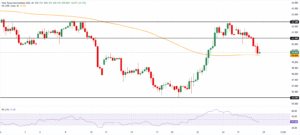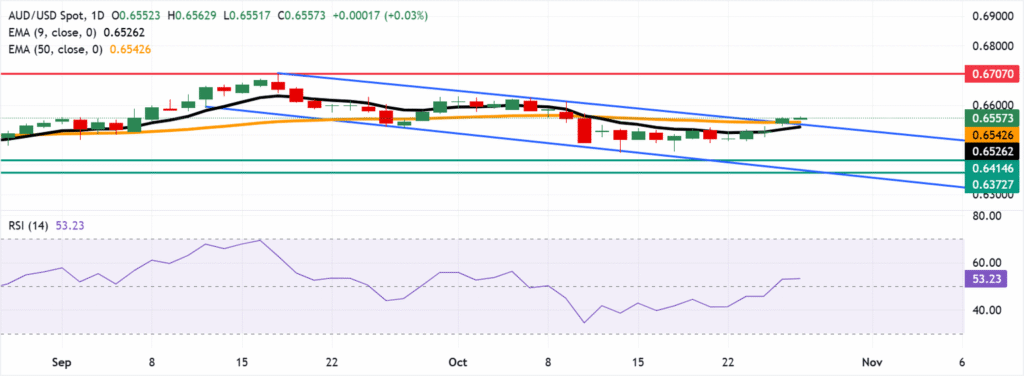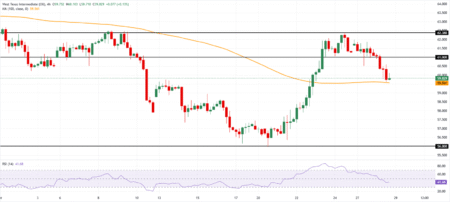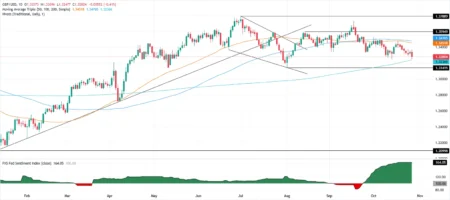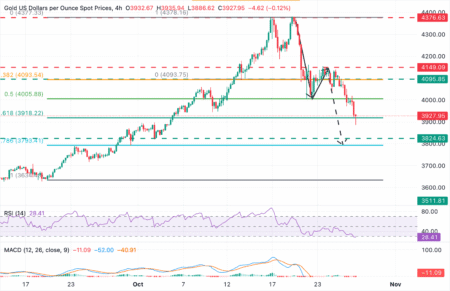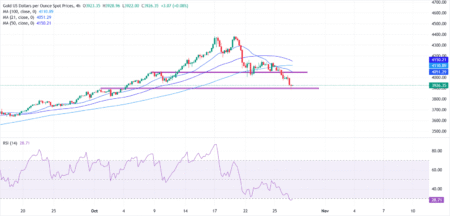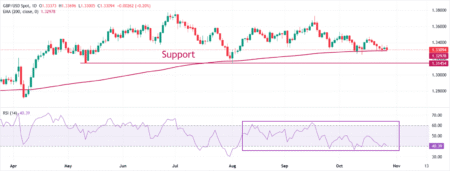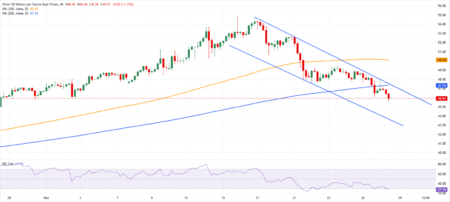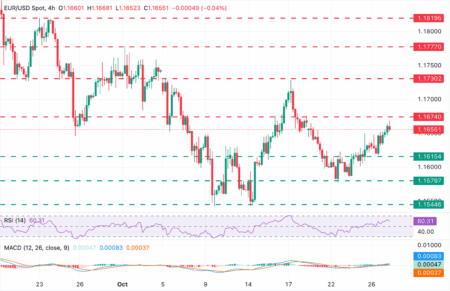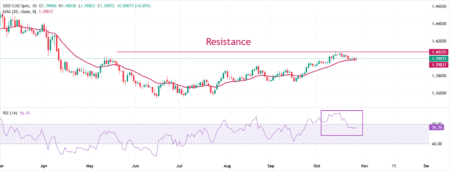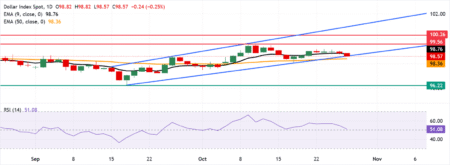The Australian Dollar (AUD) edges higher against the US Dollar (USD) on Tuesday for the second successive session. The AUD/USD pair gained ground due to decreasing rate cut bets by the Reserve Bank of Australia (RBA). Markets are now assigning only a 15% probability to a rate cut next week, a steep drop from 60% earlier, following RBA Governor Michele Bullock’s remarks on Monday.
RBA Governor Bullock reiterated that the labor market remains a little tight, despite the unemployment rate jump being a surprise. Investors are now focused on Wednesday’s release of the Q3 inflation data and the September Monthly CPI indicator for additional insight into the future path of interest rates.
The AUD also gained support from optimism over progress in the United States (US)–China trade negotiations. US and Chinese negotiators reached a consensus on major disputes, which paves the way for Presidents Donald Trump and Xi Jinping to meet on Thursday to finalize a trade deal aimed at easing tensions. Officials in Malaysia announced after two days of talks that both sides had agreed on key issues, including export controls, fentanyl, and shipping levies. Any shift in China’s economic conditions could also affect the Australian dollar (AUD), given the close trade ties between China and Australia.
US Dollar declines due to increased likelihood of Fed rate cuts
- The US Dollar Index (DXY), which measures the value of the US Dollar against six major currencies, is extending its losses and trading around 98.70 at the time of writing. The Greenback struggles as traders expect the Federal Reserve (Fed) to deliver a rate cut on Wednesday.
- The Fed is widely expected to lower interest rates by another quarter point, bringing the benchmark rate to 3.75-4.00%, at its October meeting. The CME FedWatch Tool indicates that markets are now pricing in nearly a 97% chance of a Fed rate cut in October and a 96% possibility of another reduction in December.
- The US government shutdown has ignited debate among Federal Reserve officials, as policymakers weigh whether to cut rates soon to support a weakening labor market or maintain current levels amid inflation that remains persistently above the Fed’s 2% target.
- The US Bureau of Labor Statistics (BLS) reported on Friday that the US Consumer Price Index (CPI) rose 3.0% year-over-year (YoY) in September, following a 2.9% increase in the prior month. This reading came in below the market expectation of 3.1%. Meanwhile, the monthly CPI increased 0.3%, against the 0.4% rise seen in August. The core CPI increased 0.2% month-over-month, compared to the market consensus of 0.3%, while the yearly core CPI was up 3.0% in September.
- US Treasury Secretary Scott Bessent told CBS News that President Trump’s threat to impose 100% tariffs on Chinese goods “is effectively off the table.” Bessent added that China has agreed to make “substantial” soybean purchases and to postpone its rare-earth export controls “for a year while they re-examine it.”
- The preliminary Australia’s S&P Global Manufacturing Purchasing Managers Index (PMI) fell to 49.7 in October from 51.4 prior. Meanwhile, Services PMI rose to 53.1 in October from the previous reading of 52.4, while the Composite PMI increased to 52.6 in October against 52.4 prior.
Australian Dollar holds gains above 0.6550, near 50-day EMA
AUD/USD is trading around 0.6560 on Tuesday. Technical analysis of a daily chart suggests a bullish reversal as the pair is positioned slightly above the upper boundary of the descending channel. The pair is also trading above the nine- and 50-day Exponential Moving Averages (EMAs), indicating that both short- and medium-term price momentum remain strong.
On the upside, the immediate barrier lies at the psychological level of 0.6600. A break above this level would support the AUD/USD pair to explore the region around the 12-month high of 0.6707, which was recorded on September 17.
The initial support lies at the 50-day EMA of 0.6542, followed by the nine-day EMA at 0.6526. A break below these levels would revive the bearish bias and prompt the AUD/USD pair to navigate the area around the four-month low of 0.6414, followed by the lower boundary of the descending channel around 0.6380.
AUD/USD: Daily Chart
Australian Dollar Price Today
The table below shows the percentage change of Australian Dollar (AUD) against listed major currencies today. Australian Dollar was the strongest against the US Dollar.
| USD | EUR | GBP | JPY | CAD | AUD | NZD | CHF | |
|---|---|---|---|---|---|---|---|---|
| USD | -0.18% | -0.22% | -0.55% | -0.04% | -0.09% | -0.21% | -0.25% | |
| EUR | 0.18% | -0.03% | -0.35% | 0.14% | 0.10% | -0.04% | -0.06% | |
| GBP | 0.22% | 0.03% | -0.30% | 0.18% | 0.13% | 0.00% | -0.04% | |
| JPY | 0.55% | 0.35% | 0.30% | 0.51% | 0.46% | 0.34% | 0.29% | |
| CAD | 0.04% | -0.14% | -0.18% | -0.51% | -0.05% | -0.17% | -0.22% | |
| AUD | 0.09% | -0.10% | -0.13% | -0.46% | 0.05% | -0.12% | -0.16% | |
| NZD | 0.21% | 0.04% | -0.00% | -0.34% | 0.17% | 0.12% | -0.04% | |
| CHF | 0.25% | 0.06% | 0.04% | -0.29% | 0.22% | 0.16% | 0.04% |
The heat map shows percentage changes of major currencies against each other. The base currency is picked from the left column, while the quote currency is picked from the top row. For example, if you pick the Australian Dollar from the left column and move along the horizontal line to the US Dollar, the percentage change displayed in the box will represent AUD (base)/USD (quote).
RBA FAQs
The Reserve Bank of Australia (RBA) sets interest rates and manages monetary policy for Australia. Decisions are made by a board of governors at 11 meetings a year and ad hoc emergency meetings as required. The RBA’s primary mandate is to maintain price stability, which means an inflation rate of 2-3%, but also “..to contribute to the stability of the currency, full employment, and the economic prosperity and welfare of the Australian people.” Its main tool for achieving this is by raising or lowering interest rates. Relatively high interest rates will strengthen the Australian Dollar (AUD) and vice versa. Other RBA tools include quantitative easing and tightening.
While inflation had always traditionally been thought of as a negative factor for currencies since it lowers the value of money in general, the opposite has actually been the case in modern times with the relaxation of cross-border capital controls. Moderately higher inflation now tends to lead central banks to put up their interest rates, which in turn has the effect of attracting more capital inflows from global investors seeking a lucrative place to keep their money. This increases demand for the local currency, which in the case of Australia is the Aussie Dollar.
Macroeconomic data gauges the health of an economy and can have an impact on the value of its currency. Investors prefer to invest their capital in economies that are safe and growing rather than precarious and shrinking. Greater capital inflows increase the aggregate demand and value of the domestic currency. Classic indicators, such as GDP, Manufacturing and Services PMIs, employment, and consumer sentiment surveys can influence AUD. A strong economy may encourage the Reserve Bank of Australia to put up interest rates, also supporting AUD.
Quantitative Easing (QE) is a tool used in extreme situations when lowering interest rates is not enough to restore the flow of credit in the economy. QE is the process by which the Reserve Bank of Australia (RBA) prints Australian Dollars (AUD) for the purpose of buying assets – usually government or corporate bonds – from financial institutions, thereby providing them with much-needed liquidity. QE usually results in a weaker AUD.
Quantitative tightening (QT) is the reverse of QE. It is undertaken after QE when an economic recovery is underway and inflation starts rising. Whilst in QE the Reserve Bank of Australia (RBA) purchases government and corporate bonds from financial institutions to provide them with liquidity, in QT the RBA stops buying more assets, and stops reinvesting the principal maturing on the bonds it already holds. It would be positive (or bullish) for the Australian Dollar.
Read the full article here




